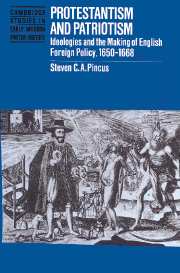Book contents
- Frontmatter
- Contents
- Acknowledgments
- List of abbreviations
- 1 Introduction
- Part I The rod of the Lord: ideology and the outbreak of the First Anglo-Dutch War
- Part II To unite against the common enemy: the 1654 Treaty of Westminster and the end of apocalyptic foreign policy
- Part III Popery, trade, and universal monarchy: ideology and the outbreak of the Second Anglo-Dutch War
- Part IV The Medway, Breda, and the Triple Alliance: the collapse of Anglican Royalist Foreign Policy
- 17 Historiographical overview
- 18 The circulation of news and the course of the war
- 19 The popular understanding of the war
- 20 The government's war aims
- 21 An Orangist revolution
- 22 Victory denied and wartime consensus shattered
- 23 The rise of political opposition
- 24 The road to Chatham: the decision not to send out a battle fleet
- 25 The demise of Anglican Royalist foreign policy
- Conclusion
- Bibliography
- Index
- Titles in the series
17 - Historiographical overview
Published online by Cambridge University Press: 01 October 2009
- Frontmatter
- Contents
- Acknowledgments
- List of abbreviations
- 1 Introduction
- Part I The rod of the Lord: ideology and the outbreak of the First Anglo-Dutch War
- Part II To unite against the common enemy: the 1654 Treaty of Westminster and the end of apocalyptic foreign policy
- Part III Popery, trade, and universal monarchy: ideology and the outbreak of the Second Anglo-Dutch War
- Part IV The Medway, Breda, and the Triple Alliance: the collapse of Anglican Royalist Foreign Policy
- 17 Historiographical overview
- 18 The circulation of news and the course of the war
- 19 The popular understanding of the war
- 20 The government's war aims
- 21 An Orangist revolution
- 22 Victory denied and wartime consensus shattered
- 23 The rise of political opposition
- 24 The road to Chatham: the decision not to send out a battle fleet
- 25 The demise of Anglican Royalist foreign policy
- Conclusion
- Bibliography
- Index
- Titles in the series
Summary
Excitement and anticipation spread throughout Europe on the eve of the first international conflict to be fought by Britain's newly restored king. “All the world and the Pope himself is big with expectation of what issue his Majesty's grand engagement with Holland will have,” gushed Charles II's envoy in Italy Joseph Kent. The English themselves were brimming with confidence and enthusiasm. The Earl of Arlington informed the English ambassador in Spain, Sir Richard Fanshawe, that “the whole people of what opinion or interest soever are greatly fond of this war.” A Venetian observer noted “the great inclination of the people here to the rupture and war against the Dutch.” Even the exceedingly cautious William Coventry marveled at the unanimity of the fleet. “I have not heard one rodomontade from any of them,” Coventry wrote to Arlington, instead all of the seaman displayed “an assurance of beating [the Dutch].”
English confidence was matched by the government's naval preparations. The Irish Viscount Conway wrote to his countryman Sir George Rawdon that Charles II had prepared “the powerfullest fleet that ever went out of England.” “I believe the English fleet the most considerable that any one monarch has ever put to sea,” Samuel Tuke informed his friend Sir John Evelyn. The English Admiral James Duke of York proudly recorded in his memoirs that the nation “never hitherto had seen [a fleet] so glorious and formidable.”
- Type
- Chapter
- Information
- Protestantism and PatriotismIdeologies and the Making of English Foreign Policy, 1650–1668, pp. 271 - 275Publisher: Cambridge University PressPrint publication year: 1996

